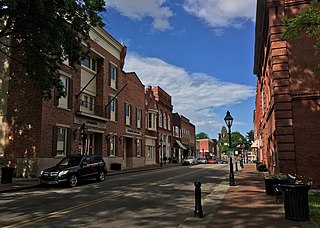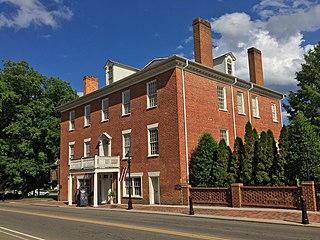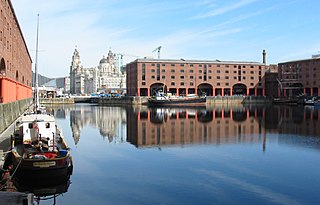
Ebbing and Flowing Spring is a spring located in Hawkins County, Tennessee, near Rogersville, that is one of only two known springs in the world to exhibit tidal characteristics.

Ebbing and Flowing Spring is a spring located in Hawkins County, Tennessee, near Rogersville, that is one of only two known springs in the world to exhibit tidal characteristics.
The spring is located on land that once belonged to Colonel Thomas Amis, father-in-law of Rogersville's founder, Joseph Rogers. It is referred to as "Sinking Spring" in a land grant given to Amis by the General Assembly of North Carolina for his services during the American Revolution. Amis settled the area in around 1780. His fort-like house is a few tenths of a mile from the spring.
Ebbing and Flowing Spring is one of only two known springs in the world to exhibit tidal characteristics with a predictable regularity.[ citation needed ]
During a period of 2 hours and 47 minutes, the spring's flow ranges from an indiscernible trickle to 500 US gallons (1,900 L; 420 imp gal) per minute. The water in Ebbing and Flowing Spring maintains a constant temperature of 34 °F (1 °C).
The spring was credited with having extraordinary powers in matters of the heart by the citizens of nearby Rogersville. Townspeople claimed that any couple drinking from the spring at the peak of its flow would marry within the year. Some legends suggest that the spring's power was first discovered by Rogersville founder Joseph Rogers, who was said to have drunk from the spring with his beloved, Mary Amis, who soon after became his wife, despite her father's initial disapproval.
The spring is privately owned by descendants of Thomas Amis, but it is open to the public. Local tourism agencies maintain directions and brochures about the spring. The property is now owned by Orphia Gibbs.

Tides are the rise and fall of sea levels caused by the combined effects of the gravitational forces exerted by the Moon and are also caused by the Earth and Moon orbiting one another.

A strait is a landform connecting two seas or two water basins. While the landform generally constricts the flow, the surface water still flows, for the most part, at the same elevation on both sides and through the strait in both directions. Most commonly, it is a narrowing channel that lies between two land masses. Some straits are not navigable, for example because they are either too narrow or too shallow, or because of an unnavigable reef or archipelago. Straits are also known to be loci for sediment accumulation. Usually, sand-size deposits occur on both the two opposite strait exits, forming subaqueous fans or deltas.

Hawkins County is a county located in the U.S. state of Tennessee. As of the 2020 census, the population was 56,721. Its county seat is Rogersville, Hawkins County is part of the Metropolitan Statistical Area, which is a component of the Johnson City-Kingsport-Bristol, TN-VA Combined Statistical Area, commonly known as the "Tri-Cities" region.

Hancock County is a county located in the northeastern part of the U.S. state of Tennessee. As of the 2020 census, the population was 6,662, making it the fourth-least populous county in Tennessee. Its county seat is Sneedville.

Rogersville is a town in, and the county seat of, Hawkins County, Tennessee, United States. It was settled in 1775 by the grandparents of Davy Crockett. It is named for its founder, Joseph Rogers. Tennessee's second oldest courthouse, the Hawkins County Courthouse, first newspaper The Knoxville Gazette, and first post office are all located in Rogersville. The Rogersville Historic District is listed on the National Register of Historic Places.

U.S. Route 11W (US 11W) is the western branch of US 11 from the twin cities of Bristol, Tennessee/Bristol, Virginia, where US 11 splits into US 11E and US 11W, to Knoxville, Tennessee, where the two highways rejoin. The highway serves the Appalachia region's Ridge-and-Valley section of East Tennessee, bounded by the Clinch Mountain ridge to the north and the Holston River to the south. US 11W from Bristol to Bean Station and Blaine to Knoxville are designated as part of the National Highway System.
Tennessee's 1st congressional district is the congressional district of northeast Tennessee, including all of Carter, Cocke, Greene, Hamblen, Hancock, Hawkins, Johnson, Sullivan, Unicoi, Washington, and Sevier counties and parts of Jefferson County. It is largely coextensive with the Tennessee portion of the Tri-Cities region of northeast Tennessee and southwest Virginia. With a Cook Partisan Voting Index rating of R+30, it is the most Republican district in Tennessee.

Overton Lodge No. 5 is a Freemason lodge under the Grand Lodge of Tennessee. Overton Lodge is located on the Courthouse Square in Rogersville Historic District in downtown Rogersville, Tennessee in the United States.

Hale Springs Inn, built in 1824 on the Courthouse Square in Rogersville, Tennessee, was the oldest continuously-operated Inn in Tennessee. It is listed as a contributing property of the Rogersville Historic District.

Joseph Rogers (1764–1833) was an Irish-born pioneer and settler who, with his father-in-law Thomas Amis, founded the town of Rogersville, Tennessee in 1789.

Amis House is a pioneer settlement in Hawkins County, Tennessee near Rogersville, built in 1780–2 by Thomas Amis, the father-in-law of Rogersville founder Joseph Rogers.

The Hawkins County Courthouse is the seat of county government for Hawkins County, Tennessee, United States, located in the city of Rogersville. It was built in 1836, it is one of six antebellum courthouses still in use in Tennessee, and it is the second oldest courthouse still in use in the state.

Price Public Elementary School, now known as Price Public Community Center and Swift Museum, is a former African-American school in Rogersville, Tennessee. It currently serves as a community center and home of the Swift Museum.

The Rogersville Historic District is a historic district in Rogersville, Tennessee, the county seat of Hawkins County. It is both a local historic district and a National Register of Historic Places historic district.

Pressmen's Home is a non-abandoned ghost town and former headquarters for the International Printing Pressmen and Assistants' Union of North America from 1911 to 1967, in the Poor Valley area of Hawkins County, Tennessee, United States, nine miles north of Rogersville. It included a trade school, a sanitarium, a retirement home, a hotel, a post office, a chapel, a hydroelectric power production plant, telecommunication utilities, and other facilities designed to make it a self-sufficient community.
The Battle of Rogersville was a conflict in and around the town of Rogersville, Tennessee, on the morning of November 6, 1863, between the United States Army 3rd Brigade, 4th Cavalry Division and the Confederate States Army Jones' Brigade, 2nd Cavalry Brigade and the 8th Virginia Cavalry. Because Federal forces were caught largely by surprise, the Confederates, under Brigadier General William E. Jones, were able to recapture Rogersville along with significant supplies from the town's railroad storehouses.

Tennessee marble is a type of crystalline limestone found only in East Tennessee, in the southeastern United States. Long esteemed by architects and builders for its pinkish-gray color and the ease with which it is polished, this stone has been used in the construction of numerous notable buildings and monuments throughout the United States and Canada, including the National Gallery of Art and the National Air and Space Museum in Washington, D.C., the Minnesota State Capitol, as well as parts of the United States Capitol in Washington, Grand Central Terminal in New York, and Union Station in Toronto. Tennessee marble achieved such popularity in the late-19th century that Knoxville, the stone's primary finishing and distribution center, became known as "The Marble City."

John Crockett was an American frontiersman and soldier, and the father of David "Davy" Crockett.

A floating dock, floating harbour or wet dock is a dock alongside a tidal waterway which maintains a 'constant' level, despite the changing tides.
This article includes a list of references, related reading, or external links, but its sources remain unclear because it lacks inline citations .(July 2014) |